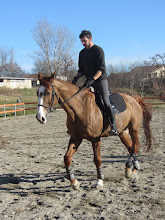February 20, 2012
February 3, 2012
Flaps replacement
This is the report of a restoration made on an english saddle. I began this service last friday with an earthquake and ended it yesterday, under 50 cm of arctic snow...
The saddle in point is a Biarritz by Devoucoux, one of my preferred master saddlers, still one of them even after looking inside the belly of his product. Also this famous french brand uses leather covered flaps and, as all leather covered flaps, they wear out.
How flaps looked like when I received the saddle:
Also the grain base under the soft leather covering presented some wear points. I started to disassemble the saddle, taking down panel as first. Here are the back screws, hidden by wool wads:
Then I cut the panel stitching at the pommel and down under knee rolls:
As I took down panel, I exposed the flaps's fixing screws:
Had to remove nails and staples too:
This model has flaps stitched together with the sweat flap and the pommel "nose", so I had to remove them all. This small brass nails kept sweat flap at cantle:
Pommel's "nose":
And finally, whole flaps part separated from seat:
The seat alone:
I put aside seat and continued to disassemble the flaps. Here below I'm unstitching knee rolls:
Then, separating soft leather covering from the grain base:
Marginal note...
When opening "famous" saddles, there's always the risk of getting disappointed in matter of manufacture and materials. Under some minor aspects, this counts also for this Devocoux; leather is still top quality; the tree, even if not wrapped in gauze, is really well dressed and after all this is still a hand-built saddle... even if panels are made of felt instead of wool flocking and self-threading screws and staples replace traditional nails.
When opening "famous" saddles, there's always the risk of getting disappointed in matter of manufacture and materials. Under some minor aspects, this counts also for this Devocoux; leather is still top quality; the tree, even if not wrapped in gauze, is really well dressed and after all this is still a hand-built saddle... even if panels are made of felt instead of wool flocking and self-threading screws and staples replace traditional nails.
So, this is how panels look like now:
Knee rolls, pommel "nose" and sweat flap are still a single body, then the grain bases cleaned from old stitching threads and some minor parts.
Now it's time to cover flaps with new leather. Maybe it's because I hate leather covered flaps. Maybe it's because I wanted to do a long lasting restoration. Then I choosed 3 mm hazel Sedgwick shoulder. Here's the flap outline marked on the back of leather:
After glueing base and new leather together, let's cut:
And here are the new flaps:
No, I'm not colour-blind... Sometimes you need to have faith ;)
Here's what I've done for tracing stitching lines on new flaps:
Then this:
But before that I've made new holes for stirrup leather's loops:

And burnished edges, so old and new leather will look more even. Usual routine: edging, wetting, polishing, soaping, polishing again, colouring, then polishing again, fixing with acrylic. Here's a summary:
All the other stitching work is parallel to leather edges, so I can mark them with compasses:
During the stitching phase I tried to re-use old stitching holes. I love clean works.
I decided for a natural, unbleached thread: I know it will look brighter than original, but I'm sure it will get better with regular use. I began from the decorative stitching. This is how I re-aligned old holes:
I decided for a natural, unbleached thread: I know it will look brighter than original, but I'm sure it will get better with regular use. I began from the decorative stitching. This is how I re-aligned old holes:
I applied glue on both surfaces and marked 3 holes, then placed 3 needles into the holes...
...I used the needles as guidelines for re-joining parts. Same tecnique I've used for knee rolls (with many more needles). Here are the flaps after the first stitchings:
Next stitching line re-assembled flaps with knee rolls, sweat flap, etc. Here's first flap, ready after all the stitches got done:
New leather is firm and stiff, so I did this to loosen it up a little:
Finally, new flaps are ready:
About 28 meters of unbleached linen thread for stitching all. Now it's oiling time:
Ready for reassembling the saddle:
I don't usually oil leather halfway a job... but this time is a little different, as some points will become hard to reach with oil when saddle will be fully assembled. Last step before getting panel and seat together:
When re-assembling I used steel nails instead of staples. I don't have a staple gun, nor I want one!!
At this point I used pics I've shot during disassembly as reminders for putting everything at its place. I've been able to recycle both original nails (the ones with DEVOUCOUX - BIARRITZ mark) and stainless steel D staples. Here's how seat, flaps and sweat flap looked like:
It only took to get panel back to its place now:
18 hours total, 9 hours of stitching.
Subscribe to:
Posts (Atom)














































